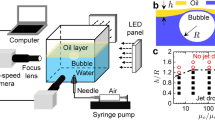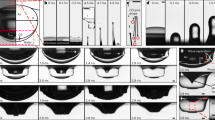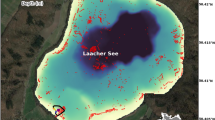Abstract
THE formation of drops, as the result of a gas or vapour bubble bursting at the surface of water, has been attributed to the break-up of the jet formed when liquid flows into the crater left by the burst bubble, and photographic evidence indicates that large drops are, in fact, formed in this way1.
This is a preview of subscription content, access via your institution
Access options
Subscribe to this journal
Receive 51 print issues and online access
$199.00 per year
only $3.90 per issue
Buy this article
- Purchase on SpringerLink
- Instant access to full article PDF
Prices may be subject to local taxes which are calculated during checkout
Similar content being viewed by others
References
Woodcock, A. H., Kientzlen, C. F., Arons, A. B., and Blanchard, D. C., Nature, 172, 1145 (1953).
Author information
Authors and Affiliations
Rights and permissions
About this article
Cite this article
KNELMAN, F., DOMBROWSKI, N. & NEWITT, D. Mechanism of the Bursting of Bubbles. Nature 173, 261 (1954). https://doi.org/10.1038/173261a0
Issue date:
DOI: https://doi.org/10.1038/173261a0
This article is cited by
-
Sodium and lithium ions in aerosol: thermodynamic and rayleigh light scattering properties
Theoretical Chemistry Accounts (2020)
-
Revising the hygroscopicity of inorganic sea salt particles
Nature Communications (2017)
-
Skin Penetration of Fatty Acids from Soap Surfactants in Cleansers Dependent on Foam Bubble Size
Journal of Surfactants and Detergents (2014)
-
Micro droplets generated on a rising bubble through an oppositely charged oil/water interface
Journal of Visualization (2012)
-
X-Ray Observation of Gas Evolution, Flotation, and Emulsification of Molten Carbon Steel Immersed in Mold Flux
Metallurgical and Materials Transactions B (2011)



